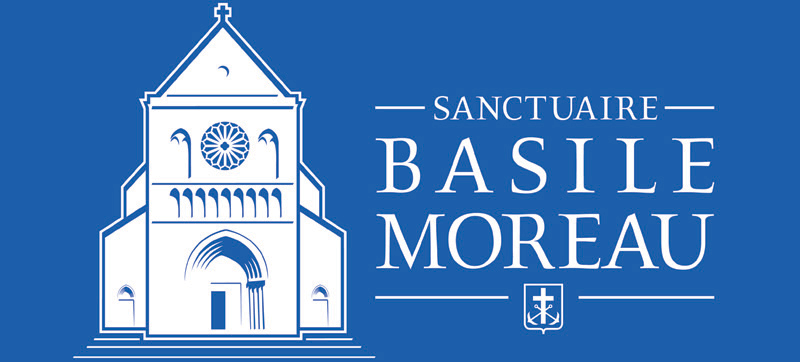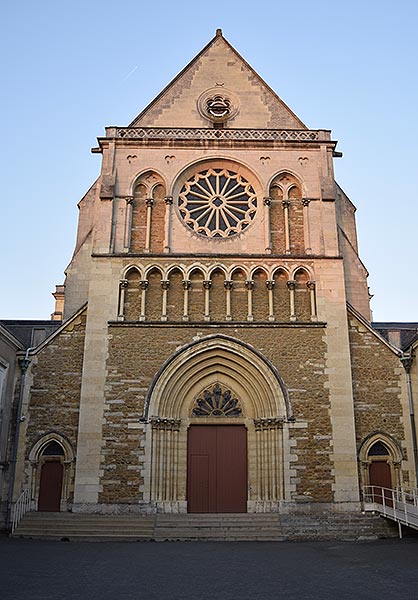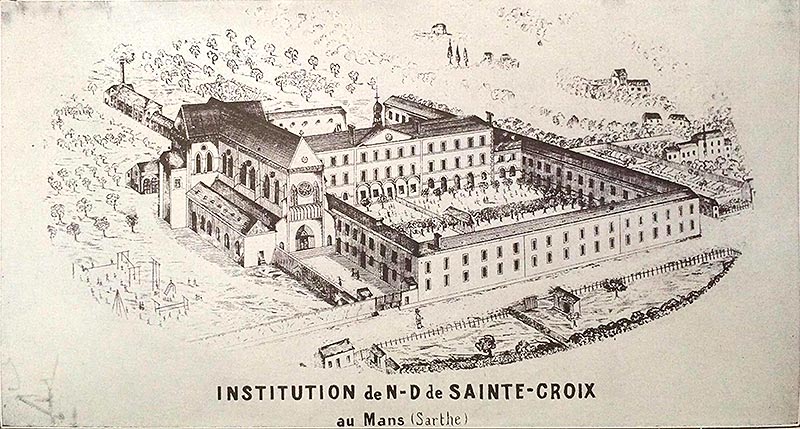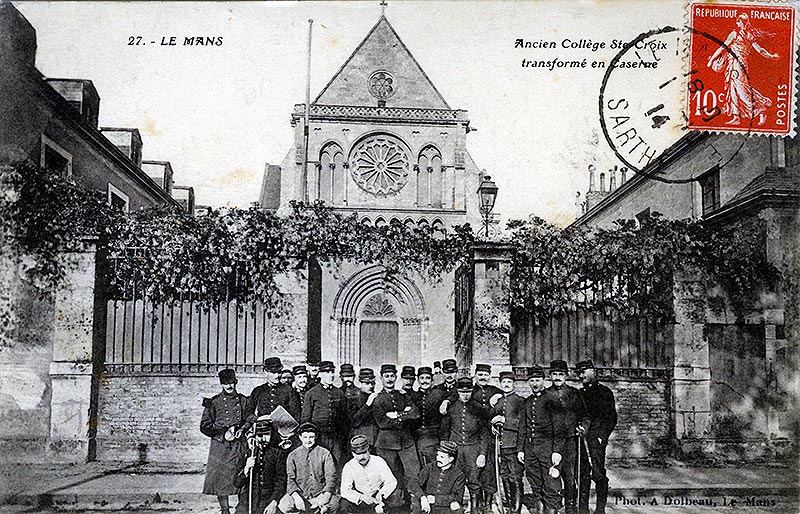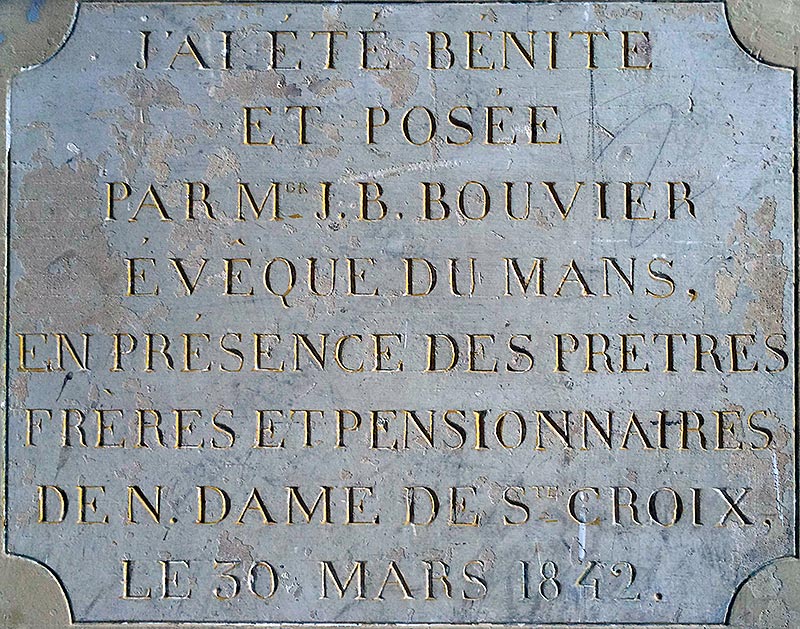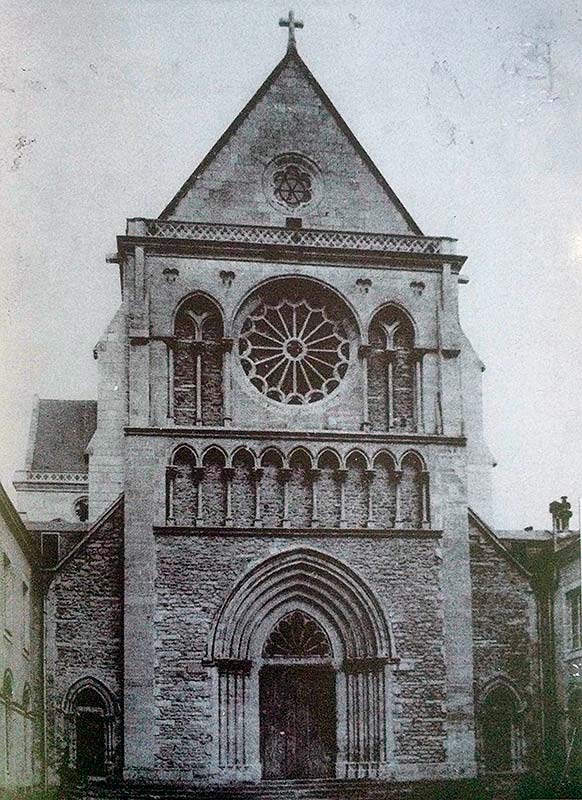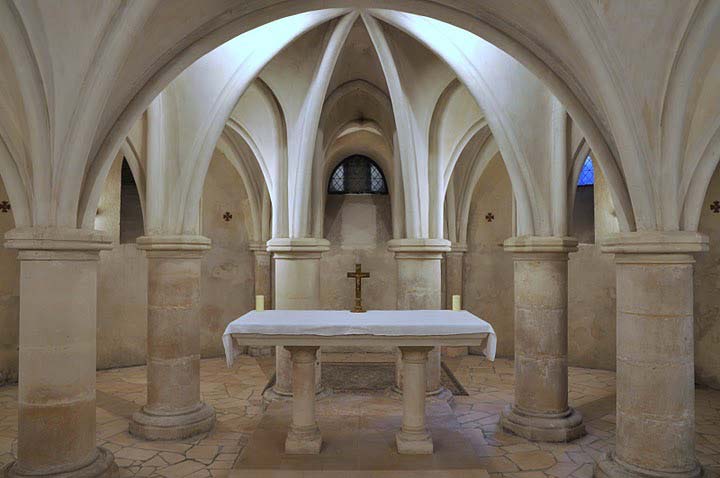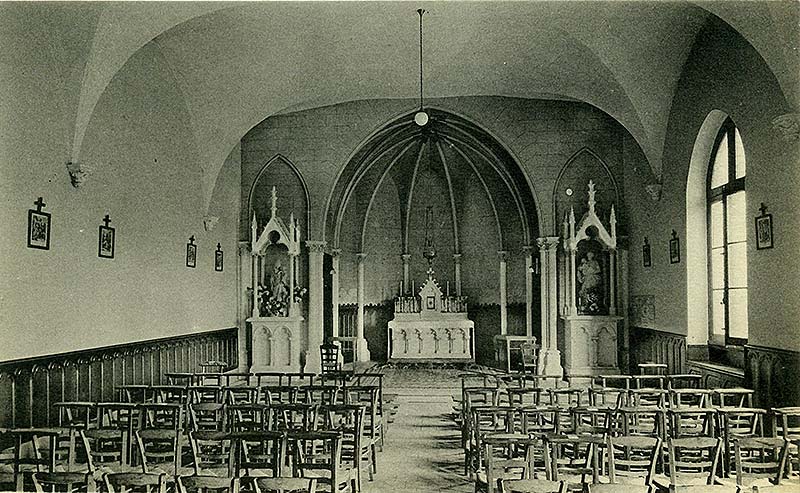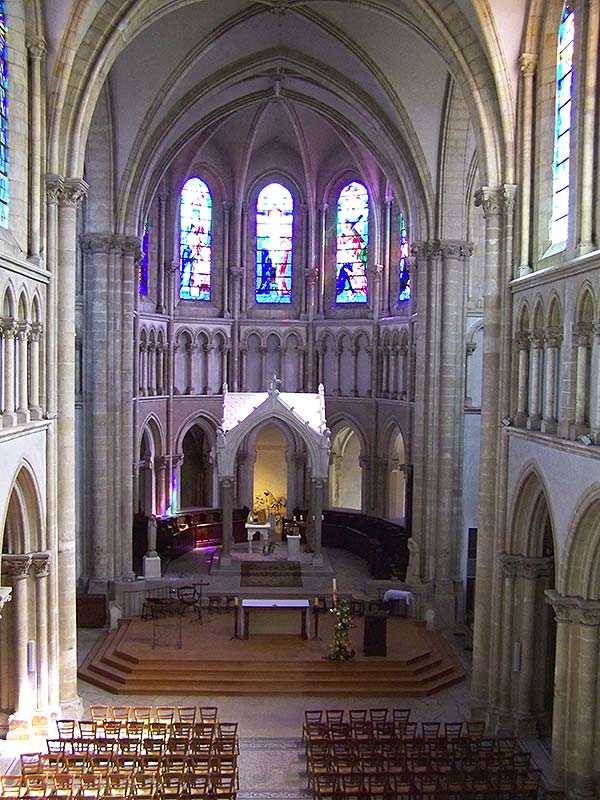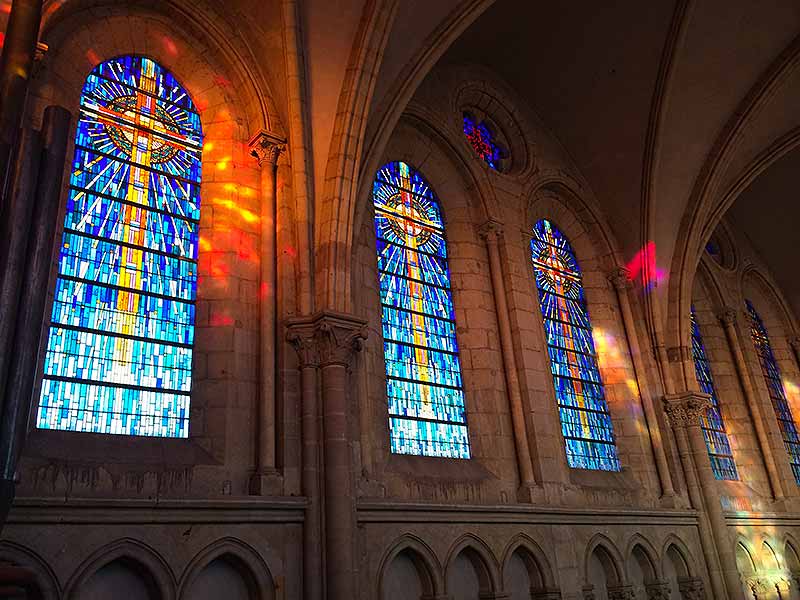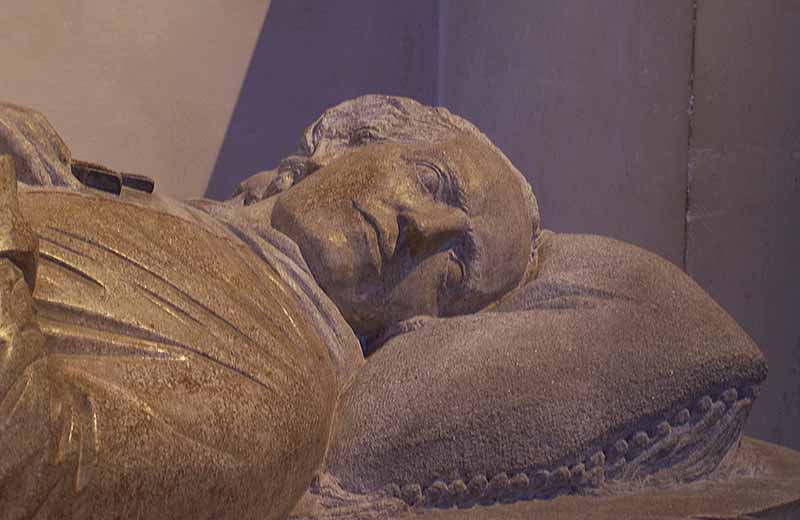Notre-Dame de Sainte-Croix
Notre-Dame de Sainte-Croix (Our Lady of Holy Cross) is the site of the foundation of the religious family of Holy Cross and the symbolic center of what Father Founder called the “work of God”.
Father Moreau received the property as a gift on December 24, 1832 from Abbé Jobbé Delile, a fellow priest of the Diocese of Le Mans and honorary canon of the Cathedral. Called Notre-Dame de Bel-Air, the main house with additional buildings and surrounding property totaling over 36,000 square meters (or approximately 9 acres) was located in a commune just to the east of Le Mans called Sainte-Croix-lès-le Mans (Holy Cross near Le Mans).
Father Moreau named the site Notre-Dame de Sainte-Croix after the name of the commune and in recognition of the already existing devotion to Our Lady at the site (Notre-Dame de Bel-Air). On November 1, 1835, he installed here the Brothers of Saint Joseph, over whom he had received authority from Abbé Jacques Dujarié, the pastor of Ruillé-sur-Loir. Following the completion of a building expansion and remodeling project on the property in the spring of 1837 and the signing of the Fundamental Pact (March 1, 1837), which prepared the way for the definitive union of the Brothers of Saint Joseph and the Auxiliary Priests, Father Moreau transferred here his Auxiliary Priests and a pensionnat (primary boarding school) from the nearby Barré House. A year later, a small community of women was organized to assist with the domestic services of the pensionnat. Thus the religious family of Holy Cross – Josephites (lay brothers), Salvatorists (priests), and Marianites (Sisters) – began to take shape.
Notre-Dame de Sainte-Croix was the site of the profession of vows, first for the brothers (1836), later for the priests (1840), and then for the sisters (1841). From Notre-Dame de Sainte-Croix, brothers would go forth to teach and establish schools, and auxiliary priests would go forth to preach parish missions. Eventually, brothers, priests, and sisters alike would be sent by Father Moreau to respond to the needs of the Church in distant lands. At Notre-Dame de Sainte-Croix, ceremonies of adieu took place before the departure of missionaries for Algiers (1840), America (1841), Italy (1850), Canada (1852), Bengal (1852), and Poland (1856). Far from home, it was to the motherhouse at Notre-Dame de Sainte-Croix that the eyes of missionaries would turn, receiving from there the assurance of prayer and the affectionate sentiments expressed by their beloved father and founder.
Institution Notre-Dame de Sainte-Croix
The Institution Notre-Dame de Sainte-Croix – which refers specifically to the educational apostolate at Notre-Dame de Sainte-Croix – was begun by Father Moreau in 1836 when he moved to Sainte-Croix-lès-le Mans the small pensionnat (primary boarding school) formerly run by the Brothers of Saint Joseph in Ruillé-sur-Loir. Persevering in the face of stiff opposition arising from the civil authorities, Father Moreau overcame many obstacles to expand and develop the school. In 1838, he introduced the teaching of Latin (a beginning secondary education subject). In 1839, the school received the rank of “Institution”, which allowed for the teaching of the humanities. In 1843, Father Moreau established an academy of academic excellence in the institution, as well as a conference of the Saint Vincent de Paul Society. In 1845, the institution began to admit externes (day-students). Finally, in 1849, the institution was granted the long-sought-after “full teaching rights”, which allowed it to teach rhetoric and philosophy.
Thus, the educational apostolate at Notre-Dame de Sainte-Croix grew to become the largest and most important apostolate of the religious family of Holy Cross, and remained so for many years. It knew much success, attracting nationally known scholars (both clergy and lay), while providing an important service to families and to society. In 1849, it was described in a Paris newspaper as “an establishment which offers to Christian youth all the resources of talent and of science, as well as all the guarantees of virtue and of religion.” (Charles Moreau, vol 1, p 343).
Sadly, the Institution Notre-Dame de Sainte-Croix was lost to Father Moreau forever when the Congregation, in its 1868 chapter legislation, decreed the sale of the Congregation’s properties in Le Mans. Moreau’s beloved institution and chapel (see below) were sold at auction on October 2, 1869 and were purchased by the Marquis de Nicolay. The following May, the Society of Jesus took possession of the school (and the adjoining chapel). Their ministry on the site was short-lived, however. The decree of 29 mars 1880 by the French minister for public education, Jules Ferry, prohibited the Society of Jesus from engaging in the educational apostolate. Later laws, including the 1901 law that stripped religious congregations of legal recognition, and the law that decreed the separation of Church and State in 1905, led to the abandonment of the Sainte-Croix campus in 1911 and the transfer of the school to the former Capucin convent several hundred meters away. In 1914, the school was moved to a third and final location (rue des Vignes, now rue Antoine de Saint-Exupéry), where the Lycée Sainte-Croix remains even to today.
As for the first Notre-Dame de Sainte-Croix campus, it was appropriated by the State in 1911. The parks and gardens leading up to Father Moreau’s beloved Solitude of the Savior were divided into lots and sold. The school buildings, including those attached to the church of Notre-Dame de Sainte-Croix, were turned into military barracks (Caserne Mangin) and, later, into military offices. These buildings were sold and converted into private homes and apartments in 2016.
Church of Notre-Dame de Sainte-Croix
“I wished to leave to the family of Holy Cross a temple where at times all its members might meet in common prayer, a sanctuary to arouse the respect and build up the piety of the pupils in the college attached to the motherhouse and, which at the same time, would be of service to the people of the neighborhood.” (Blessed Basil Moreau, Circular Letter, 1 January 1857)
The cornerstone of the church of Notre-Dame de Sainte-Croix was blessed by Monseigneur Jean-Baptiste Bouvier, bishop of Le Mans, on March 30, 1842, in the presence of priests, brothers, and pensionnaires (boarders) of Sainte-Croix. The church was finally consecrated on June 17, 1857 by Cardinal Donnet, archbishop of Bordeaux, in the presence of nine other bishops and of Dom Guéranger, Abbot of Solesmes.
Seeing the building of the church through to completion was a tremendous undertaking, and one that was accomplished only as a result of Father Moreau’s determination and reliance on divine grace. As stated in a local newspaper on the occasion of the church’s consecration:
“One man alone, left to his own resources, a humble priest, the Founder of a congregation…wanted to build a church, a real church, and he did. For the space of fourteen years, at the cost of personal sacrifice, tenacity of purpose, and confidence in God, and after having been obliged to stop all work for lack of money and to resume work without knowing if he would be able to continue for even six months, this humble priest went on tenaciously and, whenever it became necessary, took his place among the workmen, along with his religious.” (La Chronique de l’Ouest)
Calm and harmony
Dedicated in honor of Our Lady of Sorrows and of the Cross of Christ, the church was intended to serve as both chapel for the adjoining Institution and as conventual church for the religious family of Holy Cross. Built in neo-Gothic (14th century) style, it represents one of the beautiful achievements of the priest-architect Magloire Tournesac (1805-1875). As described by Moreau biographers Étienne and Tony Catta:
“The church of Notre-Dame de Sainte-Croix is not only a pious sanctuary but it is also a standing witness to that characteristic of calm grandeur, which Father Moreau wanted to impress on the motherhouse of Holy Cross. The purity of its lines evidences great respect for architectural tradition; the plans of the church reflect no exaggeration; there is neither imitation nor superfluous ornamentation. The entire structure is stamped with a sense of proportion.
The façade, surmounted by a rose window set between double-arched windows, ends in a simple pointed gable. At the entrance, there is a large door with closely placed arches, surmounted by an elegant gallery lined with little columns. Lastly, above the rose window, there is a very modest relief.
Within the church, we are struck by a sense of beautiful, simple harmony. The nave, eight meters wide and eighteen meters high, is lighted by twelve double windows and flanked by two minor naves. The transept, twenty-six meters wide; the choir and the apse, which give the church a total length of fifty-four meters; the organ loft supported by three arches, above which we find the rose window dominating the entrance; the high windows of the choir transept; the massive pillars supporting the vaults and surrounding the choir – the entire structure represents a visible effort to rear toward the heavens a clear-cut and pure arch, lifted up like a prayer in the calm of a soul finding in God its refuge and its strength.” (Canon Étienne Catta and Tony Catta, Basil Moreau and the origins of the Congregation of Holy Cross, Fides 1950)
Crypt and chapel
The church crypt, with its vaulted ceiling and thick pillars, was a place to which Father Moreau would often go for quiet recollection and to pray the Stations of the Cross. It was his intention that the crypt serve as a shrine for the child-martyr, Saint Eutychius, whose relics were transferred here in solemn procession on July 5, 1853. The crypt also served as the locus of Father Moreau’s devotion to the Holy Face of Jesus. It was here that an oil lamp continuously burned before an image of the Holy Face during Father Moreau’s 1857 voyage to America.
On the north side of the church is the former chapter room. Father Moreau would preside at congregational meetings from the large chair that is now found in the church sanctuary. It was in this very chapter room where, on June 21, 1866, in a poignant discourse before many tear-filled eyes, Father Moreau announced his resignation as Superior General.
In the century and half since its construction, the church has known a complicated and sometimes painful history. Sold at auction in 1869 along with the adjoining Institution Notre-Dame de Sainte-Croix, the Society of Jesus came into possession of the church in 1870. They made certain modifications to the church, including the installation of new windows and the conversion of the chapter room into a chapel (Chapel of Christ the King).
When, in 1911, the adjoining school was appropriated by the State and converted into an army barracks (caserne), the church was used as a military storage depot. It would remain so for the next twenty years.
A new consecration
Owing to the intervention of Cardinal Georges Grente, bishop of Le Mans from 1918-1959, the Congregation of Holy Cross retook possession of the church of their Founder in 1931. Renovation of the church included the putting in place of a large canopy over the high altar and the installation of three haut-reliefs: one of the Holy Family (south transept), another of the Sacred Heart with Saint John Eudes and Saint Margaret Mary Alacoque (north transept), and a third which once graced the main altar and can now be viewed along the wall of the south aisle. All of these are the work of French sculptor Georges Saupique (1889-1961).
The church was re-consecrated on November 9, 1937. The parish was erected the following year.
The stained glass windows
The renovation of the church also included the putting in place of new stained glass windows. Unfortunately, these were destroyed during an allied bombing campaign (August 6, 1944) aimed at the Kommandantur (German occupational command), stationed since 1940 in the Caserne Mangin. The windows in place today were fabricated after the war and installed in 1948.
“In this marian church, blue reigns, with deep blue dominant, converging homage of light and glass to She who, as Péguy said, was infinitely sorrowful, seventy and seventy times sorrowful. […] A symphony in blue major.” (Msgr. Dubois, Vicar General of the diocese of Le Mans, on the occasion of the dedication of the windows, 16 March 1948).
The seven windows in the choir present the sorrows of Our Lady: the flight into Egypt, the presentation of Jesus and the prophecy of Simeon, the loss of the child Jesus and finding him in the Temple, the meeting on the way to Calvary, the descent from the Cross, Jesus being held in the arms of his Mother before his burial, and in the center, Christ on the Cross with his Mother and the Beloved Disciple on each side.
From each of the windows in the nave, a large gold cross emerges from the light blue – marian blue – background, while the setting sun causes the gold and red of the rose window to blaze.
The four windows of the transept offer a glimpse of Holy Cross around the world: the famed University of Notre Dame (USA); the Oratory of Saint Joseph of Montreal, founded by Holy Cross Brother Saint André Bessette; the missionary activities of male and female religious of Holy Cross among the diverse peoples of Asia and America.
The four windows in the ambulatory evoke the origins of the religious family of Holy Cross, its return to the cradle of the Congregation and the establishment of the parish.
The organ and the presbytery
The organ, with its 45 registers and 3000 pipes, was inaugurated in 1949. A work of Pierre Chéron (1914-1999), it is one of the finest organs in the city of Le Mans.
The building today known as “the presbytery” was constructed by the Society of Jesus in 1873 to house the externes (day-students). The famous author – Antoine de Saint-Exupéry (1900-1944) – himself attended classes here from 1909-1911. The building later served as a Holy Cross international house of formation (scholasticate) from 1933 to 1963.
The tomb of Blessed Basil Moreau
The church is the final resting place of its originator: Blessed Basil Moreau, C.S.C. His tomb (south transept) was raised from the crypt of the church on the occasion of his beatification in 2007. The superb marble effigy is the work of the sculptor Henri Charlier (1883-1975), who also sculpted the effigy for the tomb of Dom Guéranger of the Abbey of Solesmes.
The church of Notre-Dame de Sainte-Croix is what the founder of the religious family of Holy Cross wanted it to be: “the visible center, the unifying image of his three communities (of priests, brothers, and sisters), the symbol of souls joined together as living stones in a spiritual edifice for the glory of God.” (Catta)
“My idea was to erect a lasting memorial of our love and gratitude to Jesus Christ, the sole Founder of our congregation, whose Sacred Heart has been made the object of our titular feast; to Mary, whose protection over our community has always been so evident; and finally to St. Joseph, who has so often showed himself its guardian.” (Basil Moreau, Circular Letter, 1 January 1857)
(Grateful acknowledgement to Rev. Jean Proust, C.S.C., whose historical study and writings contributed to this presentation.)
